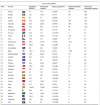Current challenges for women in orthopaedics
- PMID: 34698532
- PMCID: PMC8558445
- DOI: 10.1302/2633-1462.210.BJO-2021-0089.R1
Current challenges for women in orthopaedics
Abstract
Orthopaedics has been left behind in the worldwide drive towards diversity and inclusion. In the UK, only 7% of orthopaedic consultants are female. There is growing evidence that diversity increases innovation as well as patient outcomes. This paper has reviewed the literature to identify some of the common issues affecting female surgeons in orthopaedics, and ways in which we can address them: there is a wealth of evidence documenting the differences in the journey of men and women towards a consultant role. We also look at lessons learned from research in the business sector and the military. The 'Hidden Curriculum' is out of date and needs to enter the 21st century: microaggressions in the workplace must be challenged; we need to consider more flexible training options and support trainees who wish to become pregnant; mentors, both male and female, are imperative to provide support for trainees. The world has changed, and we need to consider how we can improve diversity to stay relevant and effective. Cite this article: Bone Jt Open 2021;2-10:893-899.
Keywords: Bias; British Orthopaedic Association; Female; Flexible training; Gender; Hidden Curriculum; Leadership; Microaggressions; Orthopaedics; Pregnancy; Sterotype; cohort study; depression; ophthalmology; orthopaedic surgeons; orthopaedic surgery; polymethyl methacrylate; postoperative complication; strength’; suturing.
Figures



Similar articles
-
Where Are the Women in Orthopaedic Surgery?Clin Orthop Relat Res. 2016 Sep;474(9):1950-6. doi: 10.1007/s11999-016-4827-y. Clin Orthop Relat Res. 2016. PMID: 27090259 Free PMC article.
-
How Do Medical Students Perceive Diversity in Orthopaedic Surgery, and How Do Their Perceptions Change After an Orthopaedic Clinical Rotation?Clin Orthop Relat Res. 2021 Mar 1;479(3):434-444. doi: 10.1097/CORR.0000000000001569. Clin Orthop Relat Res. 2021. PMID: 33231939 Free PMC article.
-
Women in Orthopaedics: A Perspective from Malaysian Female Orthopaedic Surgeons.Malays Orthop J. 2023 Mar;17(1):70-78. doi: 10.5704/MOJ.2303.009. Malays Orthop J. 2023. PMID: 37064627 Free PMC article.
-
Medical School Experiences Shape Women Students' Interest in Orthopaedic Surgery.Clin Orthop Relat Res. 2016 Sep;474(9):1967-72. doi: 10.1007/s11999-016-4830-3. Clin Orthop Relat Res. 2016. PMID: 27084717 Free PMC article. Review.
-
Perceptions of Racial and Gender Microaggressions in an Academic Orthopaedic Department.JB JS Open Access. 2023 Aug 8;8(3):e22.00150. doi: 10.2106/JBJS.OA.22.00150. eCollection 2023 Jul-Sep. JB JS Open Access. 2023. PMID: 37554580 Free PMC article. Review.
Cited by
-
DiffErential attainment and Factors AssoCiated with Training applications and Outcomes (DE FACTO) study: Trauma & Orthopaedic surgery in the UK.Bone Jt Open. 2024 Aug 22;5(8):697-707. doi: 10.1302/2633-1462.58.BJO-2024-0036.R2. Bone Jt Open. 2024. PMID: 39168474 Free PMC article.
-
Racial and Sex Disparities in Resident Attrition in Orthopaedic Surgery.JB JS Open Access. 2023 Jun 20;8(2):e22.00148. doi: 10.2106/JBJS.OA.22.00148. eCollection 2023 Apr-Jun. JB JS Open Access. 2023. PMID: 37351087 Free PMC article. Review.
-
Women's contribution to stem cell research for osteoarthritis: an opinion paper.Front Cell Dev Biol. 2023 Dec 19;11:1209047. doi: 10.3389/fcell.2023.1209047. eCollection 2023. Front Cell Dev Biol. 2023. PMID: 38174070 Free PMC article. Review. No abstract available.
-
Silent voices: Uncovering women's absence in veterinary surgery publications.PLoS One. 2025 Aug 14;20(8):e0330392. doi: 10.1371/journal.pone.0330392. eCollection 2025. PLoS One. 2025. PMID: 40811444 Free PMC article.
-
Gender diversity in UK surgical specialties: a national observational study.BMJ Open. 2022 Mar 21;12(2):e055516. doi: 10.1136/bmjopen-2021-055516. BMJ Open. 2022. PMID: 35314455 Free PMC article.
References
-
- No authors listed . 2020 entry UCAS Undergraduate reports by sex, area background, and ethnic group. https://www.ucas.com/data-and-analysis/undergraduate-statistics-and-repo... (date last accessed 10 April 2021).
-
- Moberly T. A fifth of surgeons in England are female. BMJ. 2018;363:k4530. - PubMed
-
- Sing C, Loseth C, et al. . Women in surgery: a systematic review of 25 years. BMJ Leader. 2020.
-
- Mulcahey MK, Van Heest AE, Weber K, et al. . Women in Orthopaedics: How Understanding Implicit Bias Can Help Your Practice. Instr Course Lect. 2020;69:245–254. - PubMed
-
- Green R, Steven R, Haddow K, Royal College of Surgeons . Declining applications to surgical specialist training: an ENT perspective on when we should start to worry. 2017. https://publishing.rcseng.ac.uk/doi/pdf/10.1308/rcsbull.2017.141 - DOI

